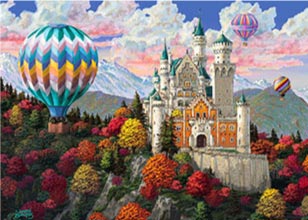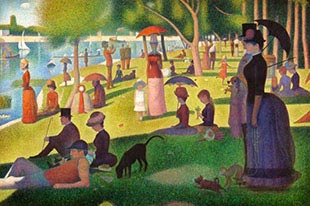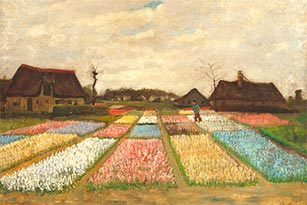History of Puzzles

Origins of Jigsaw Puzzles
The origins of jigsaw puzzles go back to the 1760s when European mapmakers pasted maps onto wood and cut them into small pieces. John Spilsbury, an engraver and mapmaker, is credited with inventing the first jigsaw puzzle in 1767. The dissected map has been a successful educational toy ever since. American children still learn geography by playing with puzzle maps of the United States or the world. The eighteenth century inventors of jigsaw puzzles would be amazed to see the transformations of the last 250 years. Children's puzzles have moved from lessons to entertainment, showing diverse subjects like animals, nursery rhymes, and modern tales of super heroes. But the biggest surprise for the early puzzle makers would be how adults have embraced puzzling over the last century.
Puzzling as a Hobby
 Puzzles for adults emerged around 1900, and by 1908 a full-blown craze was in progress in the United States. Contemporary writers depicted the inexorable progression of the puzzle addict: from the skeptic who first ridiculed puzzles as silly and childish, to the perplexed puzzler who ignored meals while chanting just one more piece; to the bleary-eyed victor who finally put in the last piece in the wee hours of the morning. The puzzles of those days were quite a challenge. Most had pieces cut exactly on the color lines. There were no transition pieces with two colors to signal, for example, that the brown area (roof) fit next to the blues (sky). A sneeze or a careless move could undo an evening's work because the pieces did not interlock. And, unlike children's puzzles, the adult puzzles had no guide picture on the box; if the title was vague or misleading, the true subject could remain a mystery until the last pieces were fitted into place.
Puzzles for adults emerged around 1900, and by 1908 a full-blown craze was in progress in the United States. Contemporary writers depicted the inexorable progression of the puzzle addict: from the skeptic who first ridiculed puzzles as silly and childish, to the perplexed puzzler who ignored meals while chanting just one more piece; to the bleary-eyed victor who finally put in the last piece in the wee hours of the morning. The puzzles of those days were quite a challenge. Most had pieces cut exactly on the color lines. There were no transition pieces with two colors to signal, for example, that the brown area (roof) fit next to the blues (sky). A sneeze or a careless move could undo an evening's work because the pieces did not interlock. And, unlike children's puzzles, the adult puzzles had no guide picture on the box; if the title was vague or misleading, the true subject could remain a mystery until the last pieces were fitted into place.
Check out our puzzle maps of the United States.
The Economy of Jigsaw Puzzles
 Because wood puzzles had to be cut one piece at a time, they were expensive. A 500-piece puzzle typically cost $5 in 1908, far beyond the means of the average worker who earned only $50 per month. High society, however, embraced the new amusement. Peak sales came on Saturday mornings when customers selected puzzles for their weekend house parties in Newport and other country retreats.
Because wood puzzles had to be cut one piece at a time, they were expensive. A 500-piece puzzle typically cost $5 in 1908, far beyond the means of the average worker who earned only $50 per month. High society, however, embraced the new amusement. Peak sales came on Saturday mornings when customers selected puzzles for their weekend house parties in Newport and other country retreats.
The next few years brought two significant innovations. First, Parker Brothers, the famous game manufacturer, introduced figure pieces into its Pastime brand puzzles. Figure pieces made puzzles a bit easier to assemble. But the fascination of pieces shaped like dogs, birds, and other recognizable objects more than offset the somewhat reduced challenge. Second, Pastimes and other brands moved to an interlocking style that reduced the risk of spilling or losing pieces. Pastime puzzles were so successful that Parker Brothers stopped making games and devoted its entire factory to puzzle production in 1909. Following this craze, puzzles continued as a regular adult diversion for the next two decades.
With the onset of the Great Depression in 1929, puzzles for adults enjoyed a resurgence of popularity, peaking in early 1933 when sales reached an astounding 10 million per week. Puzzles seemed to touch a chord, offering an escape from the troubled times, as well as an opportunity to succeed in a modest way. Completing a jigsaw gave the puzzler a sense of accomplishment that was hard to come by when the unemployment rate was climbing above 25 percent. With incomes depleted, home amusements like puzzles replaced outside entertainment like restaurants and night clubs. Puzzles became more affordable too. Many of the unemployed architects, carpenters, and other skilled craftsmen began to cut jigsaw puzzles in home workshops and to sell or rent them locally. During the 1930s craze for puzzles, drugstores and circulating libraries added puzzle rentals to their offerings. They charged three to ten cents per day, depending on size.
Mass Production and Advertising
Another important development was the introduction of die-cut cardboard puzzles for adults. Mass production and inexpensive cardboard allowed the manufacturers to cut prices substantially. There was a vogue for advertising puzzles in mid-1932. Retail stores offered free puzzles with the purchase of a toothbrush, a flashlight, or hundreds of other products. What better way to keep a brand name before the public than to have customers working for hours to assemble a picture of the product?
The autumn of 1932 brought a novel concept, the weekly jigsaw puzzle. The die-cut Jig of the Week retailed for 25 cents and appeared on the news stands every Wednesday. People rushed to buy them and to be the first among their friends to solve that week's puzzle. There were dozens of weekly series including Picture Puzzle Weekly, B-Witching Weekly, Jiggers Weekly, and (featuring popular films) Movie Cut-Ups. With the competition from the free advertising puzzles and the inexpensive weekly puzzles, the makers of hand-cut wood puzzles were hard-pressed to keep their customers. Yet the top quality brands like Parker Pastimes retained a loyal following throughout the Depression, despite their higher prices.
The Rolls Royce of Jigsaw Puzzles
Indeed the Depression led to the birth of Par Puzzles, long dubbed the Rolls Royce of jigsaw puzzles. Frank Ware and John Henriques, young men with no job prospects, cut their first puzzle at the dining room table in 1932. While other firms were cutting costs (and quality), Par steadily improved their puzzles, and marketed them to affluent movie stars, industrialists and even royalty. Par specialized in customized puzzles, often cutting the owner's name or birth date as figure pieces. Ware and Henriques also perfected the irregular edge to frustrate traditional puzzlers who tried to start with the corners and edge pieces. They further teased their customers with misleading titles and par times that were unattainable for all but the fastest puzzlers.
 After World War II, the wood jigsaw puzzle went into a decline. Rising wages pushed up costs substantially because wood puzzles took so much time to cut. And as prices rose, sales dropped. At the same time improvements in lithography and die-cutting made the cardboard puzzles more attractive, especially when Springbok introduced high quality reproductions of fine art on jigsaws. In 1965 hundreds of thousands of Americans struggled to assemble Jackson Pollock's Convergence, billed by Springbok as the world's most difficult jigsaw puzzle.
After World War II, the wood jigsaw puzzle went into a decline. Rising wages pushed up costs substantially because wood puzzles took so much time to cut. And as prices rose, sales dropped. At the same time improvements in lithography and die-cutting made the cardboard puzzles more attractive, especially when Springbok introduced high quality reproductions of fine art on jigsaws. In 1965 hundreds of thousands of Americans struggled to assemble Jackson Pollock's Convergence, billed by Springbok as the world's most difficult jigsaw puzzle.
One by one, the surviving brands of wood puzzles disappeared. Parker Brothers discontinued its Pastime puzzles in 1958. By 1974, both Frank Ware of Par and Straus (another long-time manufacturer) had retired from the business. The English Victory puzzles, easily found in department stores in the 1950s and 1960s, almost completely vanished.
As the true addicts of wood puzzles began to suffer withdrawal symptoms, Steve Richardson and Dave Tibbetts saw an opportunity to fill the void. They founded Stave Puzzles, and within a few years had succeeded Par as the leader in wood puzzles. Indeed, Stave went several steps beyond Par, by commissioning original artwork that was specially designed to interact with the cutting patterns. Experimentation with pop-up figure pieces led to three-dimensional puzzles such as a free-standing carousel. Over the years Richardson invented many trick puzzles that fit together in several different wrong ways, but with only one correct solution. Stave emphasizes personalized puzzles and service, even remembering its customers' birthdays.
Stave's success with luxury puzzles convinced others that a market could be found, leading to a broader resurgence of hand-cut and custom puzzles. The last decade has brought many design innovations as new craftspeople have turned to jigsaw puzzles. There are even some wood puzzles cut by computer-controlled water jets or lasers. Puzzle aficionados of today can choose from a number of different styles of wood puzzles to suit their passions for perplexity. And quite a few are graduating from cardboard to wood puzzles, as they discover the satisfying heft of the wood pieces, the challenge of matching their wits against an individual puzzle cutter, and the thrill of watching a picture emerge from a plain box with no guide picture on the lid.
Sources:
Anne D. Williams wrote the above article based on her book THE JIGSAW PUZZLE PIECING TOGETHER A HISTORY. Puzzle Warehouse has edited this article for brevity.
© Anne D. Williams - (Posted with Permission) For more information about Anne's Books and other literature, you can contact her at:
Anne D. Williams
Economics Dept., Bates College
Lewiston, ME 04240
e-mail: awilliam@bates.edu
Photo credits: Courtesy Cartography Associates and Courtesy Bob Armstrong's Old Jigsaw Puzzles.








